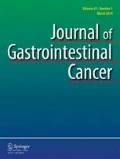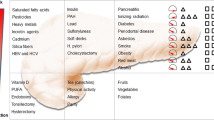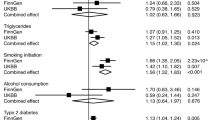Summary
The prevalence of chronic pancreatitis in tropical zones is far higher than in temperate zones, but there is no explanation for this difference. Detailed social, occupational, and dietary histories were taken from 79 patients attending two hospitals in Madras, South India. There were 53 apparently sporadic cases with both pancreatic calculi and diabetes; six apparently sporadic cases with noncalcific disease, usually with diabetes; four pairs of first-degree relatives with either calcific or noncalcific disease, with or without diabetes; and two families in which several members had one or another variant of the disease. Three trends emerged from these histories:
-
1.
Regular exposure to a xenobiotic inducer of cytochromes P450I (smoke from cigarets, burning firewood, or vehicle emissions; a cooking oil composed of C18:2 fatty acids);
-
2.
Concurrent exposure to a chemical that undergoes metabolic activation (petroleum products, notably kerosene fumes; cyanogenic glycosides; solvents; paint); and
-
3.
Low intakes of micronutrients required to synthesize/refurbish glutathione. These trends, similar to those noted at Manchester, North West England, suggest a unifying template for tissue damage in chronic pancreatitis, namely, heightened but unmitigated oxidative detoxification reactions mediated by cytochromes P450. The higher prevalence of the disease in underprivileged communities of the tropics may reflect poorer dietary availability of micronutrient antioxidants.
Similar content being viewed by others
References
Braganza JM. Chronic pancreatitis. Abstracts of International Teaching sessions of the British Society of Gastroenterology, Golden Jubilee Meeting, London, September 1987, Wiley, London, 1988; 122–125.
Worning H. Chronic pancreatitis: Pathogenesis, natural history and conservative treatment. Clin. Gastroenterol. 1984; 871–894.
Braganza JM. Free radicals and pancreatitis. Free Radicals, Chemistry, Pathology and Medicine. (Proc. Soc. Free Radical Res., St. Andrews, July 1987), Rice Evans C and Dormandy TL, eds., Richelieu, London 1988; 357–381.
Braganza JM. The role of the liver in exocrine pancreatic disease. Int. J. Pancreatol. 1988; 3: S19-S42.
WHO study group report on diabetes mellitus. WHO Technical report series 727, WHO, Geneva, 1985.
McMillan DE and Geevarghese PH. Dietary cyanide and tropical malnutrition diabetes. Diabetes Care 1979; 2: 202–208.
Viswanathan M. Pancreatic diabetes in India: an overview. Secondary Diabetes: The Spectrum of the Diabetes Syndromes, Podolsky S and Viswanathan M, eds., Raven, New York, 1980; 105–106.
Balakrishnan V, Sauniere JF, Hariharan M, and Sarles H. Diet, pancreatic function, and chronic pancreatitis in South India and France. Pancreas 1988; 3: 30–35.
Nagalotimath SJ. Pathology of calcific pancreatitis with diabetes. Secondary Diabetes: The Spectrum of the Diabetes Syndromes, Podolsky S and Viswanathan M, eds., Raven, New York 1980; 117–145.
Mohan V, Mohan R, Susheela L, Snehalatha C, Bharani G, Mahajan VK, Ramachandran A and Viswanathan M. Tropical pancreatic diabetes in South India: Heterogeneity in clinical and biochemical profile. Diabetologia 1985; 28: 229–232.
Braganza JM. Oxidant stress: Common denominator in the pathogenesis of temperate zone and tropical chronic pancreatitis? Proceeedings of WHO Workshop on malnutrition related diabetes, London June/July 1988, Alberti KGGM, Keen H, and Parry ED, eds., University Press, Oxford, in press.
Gutteridge JMC, Paterson SK, Segal AW, and Halliwell B. Inhibition of lipid peroxidation by the iron-binding protein lactoferrin. Biochem. J. 1981; 199: 259–261.
Cross CE, Halliwell B, and Allen A. Antioxidant protection: A function of tracheobronchial and gastrointestinal mucus. Lancet 1984; 1: 1328–1330.
Nebert TW, Adesnik M, Coon MJ, Estabrook RW, Gonzalez FJ, Guengerich FP, Gunsalus IC, Johnson EF, Kemper B, Levin W, Phillips IR, Sato R, and Waterman MR. The P450 gene Superfamily; recommended nomenclature. DNA 1987; 1–11.
Acheson DWK, Rose P, Houston JB, and Braganza JM. Induction of cytochromes P450 in exocrine pancreatic disease: Consequence, coincidence or cause? Clin. Chim. Acta 1985; 153: 73–84.
Acheson DWK, Hunt LP, Rose P, Houston JB, and Braganza JM. Factors contributing to the accelerated clearance of theophylline and antipyrine in adults with exocrine pancreatic disease. Clin. Sci. 1989; 76: 377–385.
Braganza JM, Jolley JE, and Lee WR. Occupational volatile chemicals and pancreatitis: A link? Int. J. Pancreatol. 1986; 1: 9–19.
Dossing M, Jacobsen O, and Rasmussen SM. Chronic pancreatitis possibly caused by occupational exposure to organic solvents. Hum. Toxicol. 1985; 4: 237–240.
Uden S, Acheson DWK, Reeves J, Worthington H, Hunt LP, Brown S, and Braganza JM. Antioxidants, enzyme induction and chronic pancreatitis: A reappraisal following studies in patients on anticonvulsants. Eur. J. Clin. Nutr. 1988; 42: 561–570.
Rose P, Fraine E, Hunt LP, Acheson DWK, and Braganza JM. Dietary antioxidants and chronic pancreatitis. Hum. Nutr. Appl. Nutr. 1986; 400: 151–164.
Mohan V, Snehalatha C, Ahmed MR, Madanagopalan N, Chari S, Jayanthi V, Malathi S, Ramachandran A, and Viswanathan M. Exocrine pancreatic function in tropical fibrocalculous pancreatic diabetes. Diabetes Care 1989; 12: 145–147.
Mohan V, Sreeram D, Ramachandran A, Viswanathan M, and Doraiswamy KR. Ultrasonographic evaluation of the pancreas in tropical pancreatic diabetes. Acta Diabetol. Latina 1985; 22: 143–148.
Pitchumoni CS. Familial pancreatitis. Pancreatic Diabetes, Pai KN, Soman CR, and Varghese R, eds., Geo, Trivandrum, 1970; 46–48.
Mohan V, Chari S, Hitman GA, Suresh S, Madanagopalan N, Ramachandran A, and Viswanathan M. Familial aggregation in tropical fibrocalculous pancreatic diabetes. Pancreas 1989; 6: 690–693.
Montgomery RD. The medical significance of cyanogen in plant food-stuffs. Am. J. Clin. Nutr. 1965; 17: 103–113.
Ballantyne Band Marrs TC. Clinical and Experimental Toxicology of Cyanides, Wright, Bristol, 1987.
Wallig MA, Gould DH, and Fettman MJ. Selective pancreatotoxicity of a naturally occurring plant nitrile. Food Chem. Toxicol. 1988; 26: 137–147.
Wade AE. Effects of dietary fat on drug metabolism. J. Environ. Pathol. Toxicol. Oncol. 1986; 6: 161–189.
Parker J, Branigan S, Houston JB, and Braganza JM. Potent induction of cytochromes P448 by corn oil-enriched diets in Syrian golden hamsters. Gut. 1986; 27: A603.
Madanagopalan N and Panchandam M. Diet, digestion and diabetes integration and an insight into current possible edible oil adulterations combination. Diet, Digestion and Diabetes. Kizaranamath B, Madanagopalan N, and Prathaokumar S, eds., Kumudam Printers Private, Madras 1987: 281–286.
Starek A, Kaminski M. Toxicity of certain petroleum derivatives used as dielectrics in electomachining V. Morphological, cytoenzymic, and biochemical changes in the liver of rats chronically exposed to kerosene hydrocarbons. Med. Pr. 1982; 33: 39–53.
Koop DR, Crump BL, Nordbloom GD, and Coon MJ. Immunochemical evidence follow- ing induction of the alcohol oxidising cytochrome P450 of rabbit liver microsomes by diverse agents: Ethanol, imidazole, trichloroethylene, acetone, pyrazole and isoniazid. Proc. Nat. Acad. Sci. USA 1985; 82: 4065–4069.
Sato A, Nakajeema T, and Koyama F. Effects of chronic ethanol consumption on hepatic metabolism of aromatic and chlorinated hydrocarbons in rats. Br. J. Ind. Med. 1980; 37: 382–386.
Weiss SJ. Oxygen, ischaemia and inflammation. Acta Phys. Scand. (Suppl. 548) 1986; 108: 9–37.
Veghelyi PV, Kemeny TT, Pozsonyi J, and Sos J. Dietary lesions of the pancreas. Am. J. Dis. Child. 1950; 79: 658–665.
Shaw S, Jayatilleke E, Ross WA, Gordon ER, and Lieber CS. Ethanol-induced lipid peroxidation: Potentiation by long-term alcohol feeding and attenuation by methionine. J. Lab. Clin. Med. 1981; 98: 417–424.
Braganza JM, Hewitt CD, and Day JP. Serum selenium in patients with chronic pancreatitis: lowest values during painful exacerbations. Trace Elements Med. 1988; 5: 79–84.
Martensson J and Bolin T. Sulfur amino acid metabolism in chronic relapsing pancreatitis. Am. J. Gastroent. 1986; 81: 1179–1184.
Guyan PM, Uden S, and Braganza JM. Heightened free radical activity in pancreatitis. Free Radical Biol. Med., in press.
Tasso F, Stemmelin N, Sarles H, et al. Comparative morphometric study of the human pancreas in its normal state and in primary chronic calcifying pancreatitis. Biomedicine 1973; 18: 134–144.
Foster J, Scott P, Hardwick J, Idle JR, Braganza JM. Immunocytochemical evidence for induction of pancreatic cytochromes P450 in chronic pancreatitis and pancreatic cancer. Paper submitted March ’90.
Schofield D, Cahloner C, Yadav S, et al. Oxidative versus detoxification pathways in patients with tropical calcific chronic pancreatitis Proc. European Pancreatic Club, Glasgow, UK, September 1989.
Wallig MA, Gould DH, Fettman MJ, and Willhite CC. Comparative toxicities of the naturally occurring nitrile, l-cyano-3,4-epithiobutane and the synthetic nitrile n-valeronitrile in rats: Differences in target organs, metabolism and toxic mechanisms. Food Chem. Toxicol. 1988; 26: 149–157.
Rao GS, Kannan K, Goel GSK, Pandya KP, and Shanker R. Subcutaneous kerosene toxicity in albine rats. Environ. Res. 1984; 35: 516–530.
Kambo PK, Hitman GA, Mohan V, Ramachandran A, Snehalatha C, Smesh S, Metcalfe K, Rynit BK, and Vismanathan M. The genetic predisposition to fibrocalculous pancreatic diabetes. Diabetologia 1989; 32: 45–51.
Rai UC and Singh DSK. Cardiopulmonary changes in mongrel dogs after exposure to kerosene smoke. Indian J. Exp. Biol. 1980; 18: 1263–1266.
Noa M and Elliat J. Induction of arotic plaques in guinea pigs by exposure to kerosene. Arch. Environ. Health 1987; 42: 31–36.
Author information
Authors and Affiliations
Rights and permissions
About this article
Cite this article
Braganza, J.M., John, S., Padmalayam, I. et al. Xenobiotics and tropical chronic pancreatitis. Int J Pancreatol 7, 231–245 (1990). https://doi.org/10.1007/BF02924446
Received:
Revised:
Accepted:
Issue Date:
DOI: https://doi.org/10.1007/BF02924446




